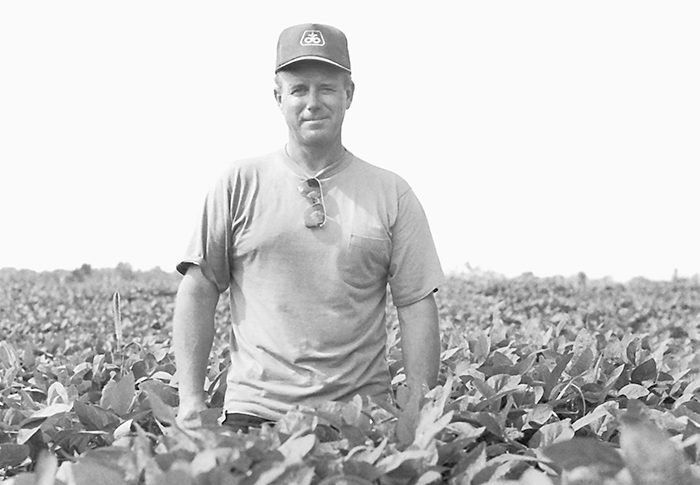Known as the father of the zone-tillage system, Ray Rawson passed away on Sept. 22. The Farwell, Mich., farmer was 79 years old.
An equipment inventor and innovator, Ray was a friend I’ve known for most of 50 years I’ve been writing about no-tillage. The holder of numerous patents, Ray was at his best when dreaming up new equipment designs and fabricating the machines in the family’s farm shop.
Along with his wife, Helen, Ray and sons Steve and Dave ran a highly-efficient large-acreage operation for many years that turned out high yields with an emphasis on fresh trend-setting ideas and a solid return on investment. The family also ran a huge on farm test plot program that looked at every aspect of reduced tillage crop production.
In the 1970s, the family made the switch to less tillage by going the no-till route, which convinced Ray that making fewer trips across fields could produce as good or better crops than folks making four or more costly tillage trips. During this time, he experimented with different style planters, different ways to create an ideal seedbed and different ways to apply nutrients. This led to development of the zone-till system.
Three-Coulter Setup
This system featured three coulters (one mounted in front of two other coulters) running ahead of each planting unit to provide a narrow-tilled area that led to what Ray felt was an ideal seedbed.
A strong believer in the zone-till system, Ray spent numerous days and nights on the road at grower meetings over the years speaking about the merits of zone tillage, soil quality, planter setups, farming vertically and other soil conserving ideas. His zone-till system ideas led to Brillion Iron Works and Unverferth Mfg. marketing several of the reduced tillage inventions that came out of his farm shop.
Soil Compaction Concerns
In a Farm Show magazine article, Ray pointed out how he was asked at many grower meeting about soil compaction concerns. His answer always had two parts. He believed most farmers definitely have compaction in their soils and a lot of farmers also have compaction between their ears. Ray said this always got some laughs from the audience, but most attendees knew it to be true.
While his early-day zone-tillage system worked well, it didn’t deal with the soil compaction issues taking place below the plant roots that caused a buildup of moisture along with roots that could not penetrate the compacted soil layer.
This led to further development of Ray’s system that ended up being called deep zone-tillage. His solution included running a slot up to 22 inches deep through the bottom of the planting zone, which helped surface water move quickly into the subsoil rather than running off the ground. This small amount of deep slot tillage allowed air, water and roots to move deeper into the soil, leading to increased biological activity, massive root growth, more earthworms and healthier soils. I recall Ray once estimating the value of earthworms in a no-till program as being the equivalent of spending $4,800 per acre on subsurface tiling.
Using the zone-tillage system, Ray harvested soybean yields as high as 118 bushels per acre and produced corn yields of over 300 bushels per acre.
Favorite Memories
While I have a number of personal no-till related memories of Ray, two are my favorites.
My in-laws lived in East Lansing, Mich., and had a summer cottage that was located only 22 miles from Ray’s farming operation. In the 1970s and 1980s, our Wisconsin-based family would spend a week or two there every summer. During these visits, I always found the time to spend an afternoon with Ray at his farm and shop.
In those days, Ray had so many new equipment ideas every spring that he was building a new planter every year. Most years, he had his planter sold by mid-summer to another zone-till farmer. This forced him to come up with a new rig before another planting season rolled around
During these mid-summer visits, it was fascinating to learn about all the new developments Ray had in mind and how he was figuring out how to get them on the new planter for the coming year. Every year his new planter was an improved model over what he had used the previous spring.
My other special no-till moment occurred when Ray took me to see a field he had rented for the first time. It was a field that had been severely compacted, had poor soil health and was suffering from poor yields.
It was a day in early August when Ray took me to see this field where he had used the deep zone tillage subsoil slot system.
As we walked through the field, I was amazed at how well the deep slot zone-tilled soybeans were growing in what had previously been a poorly-managed soil. Ray later told me the field turned ended up in the 80 bushel-per-acre range after only one year of zone tillage. I’ll never forget seeing this amazing soil health turn-around in that bean field that day with Ray.
Over the years, a number of No-Till Farmer articles have included ideas and comments from Ray. He was a speaker at a number of our National No-Tillage Conferences, including our very first one that was held in Indianapolis in 1993. He was also honored in 1997 as a No-Till Innovator for equipment design and also as one of 42 individuals named as a No-Till Legend in 2011 by our No-Till Farmer staff.
A true pioneer in the conservation tillage field, Ray Rawson’s wisdom and friendship will be missed by many farmers across America.
Ray Rawson was a frequent interviewee and subject matter expert for No-Till Farmer. To hear Ray speak in his own voice, or to read stories involving him, check out the Related Articles box below.








Post a comment
Report Abusive Comment